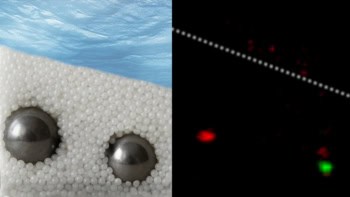A Swiss team of physicists, biochemists and doctors has constructed an array of sub-millimetre sized cantilevers to monitor blood proteins. The device, built by Youri Arntz of the University of Basel and colleagues at Basel and IBM's Zurich Research Laboratory, can measure proteins whose concentration reflects the state of a person's heart. It promises quicker and easier diagnoses of heart attacks than existing technologies, which rely on the radioactive labelling of proteins (Y Arntz et al. 2003 Nanotechnology 14 86).
The array consists of eight cantilevers, all 0.5 millimetres long, 0.1 millimetres wide and 500 nanometres thick, and coated on their upper surfaces with blood protein antibodies. When immersed in a liquid containing blood proteins, the antibodies bind to the proteins and induce a stress in the cantilevers, causing them to bend.
The researchers were able to measure this bending by monitoring a laser beam reflected by each cantilever. In their experiments, they coated one of the cantilevers with the antibodies of the creatin kinase protein, and another with the antibodies of the myoglobin protein. They immersed the array in a solution of creatin kinase and then in a solution of myoglobin, and in both cases they observed bending in the relevant cantilever.
“Cantilevers are very versatile tools for probing the nanoworld,” says Christoph Gerber, leader of the Swiss group. “The sensitivity of our device surpasses that of other nanoscale devices by several orders of magnitude.”
Other researchers have previously detected proteins using single cantilevers, but Gerber points out that multiple cantilevers are needed for real-world medical applications, such as heart monitors in intensive care units. “It is desirable that many physiological parameters are monitored simultaneously,” he says.
The device would allow medical staff to diagnose whether or not someone has had a heart attack more quickly than is possible with existing tests on blood proteins. It would permit real-time, continuous monitoring of a person’s heart and, since it is compact, could be placed at the bed side. However, the system probably won’t be sensitive enough to undergo clinical trials for several years. To reach clinical sensitivity, the researchers must pack antibodies more efficiently onto the surface of each cantilever.



